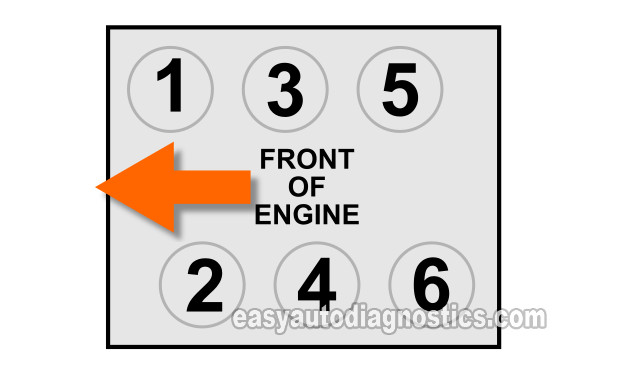
Fuel injectors don't last forever and when they fail, your 2.7L V6 engine's performance is going to suffer.
Fortunately for the DIY'er, they can tested by doing a multimeter resistance test and comparing the resistance value to the factory specification.
The only 'hard' part, of testing the fuel injectors on the 2.7L V6 Dodge/Chrysler engine is that the upper intake manifold plenum needs to be removed to get to them.
Contents of this tutorial at a glance:
![]() You can find this tutorial in Spanish here: Cómo Probar Los Inyectores De Combustible (1998-1999 2.7L Intrepid Y Concorde) (at: autotecnico-online.com).
You can find this tutorial in Spanish here: Cómo Probar Los Inyectores De Combustible (1998-1999 2.7L Intrepid Y Concorde) (at: autotecnico-online.com).
NOTE: This tutorial applies only to the indicated 2.7L V6 equipped vehicles listed in the Applies To: box on the right column.
Symptoms Of A Bad Fuel Injector

In a nutshell, each of the 6 cylinders on your 2.7L V6 engine needs air, fuel, and spark to produce power. If any of these 3 things is missing from the mix, the affected cylinder will misfire.
This means that if a fuel injector is not spraying fuel (or enough of it) you'll have a bonafide misfire on your hands.
Now, a misfire condition is not the only symptom that your vehicle may experience. Here are some more specific symptoms:
- Rough idle.
- Lack of power.
- Hesitation when you accelerate your 2.7L V6 equipped Dodge (Chrysler) down the road.
- Since your vehicle is OBD II equipped, you'll see a misfire diagnostic trouble code (DTC):
- P0300: Random Cylinder Misfire.
- P0301: Cylinder #1 Misfire.
- P0302: Cylinder #2 Misfire.
- P0303: Cylinder #3 Misfire.
- P0304: Cylinder #4 Misfire.
- P0305: Cylinder #5 Misfire.
- P0306: Cylinder #6 Misfire.
Now, what you and I need to keep in mind is that fuel injectors don't fail in just one specific way. Below is a brief description of the most common types of fuel injector failure:
- The fuel injector suffers an internal short-circuit or an open-circuit problem. When this happens, fuel injector stops injecting fuel.
- The fuel injector becomes clogged and doesn't atomize the fuel correctly.
- It comes on and does not turn off (due to electrical issues). In other words: it does not pulse ON and OFF but stays on all of the time spraying a tremendous amount of fuel as soon as you turn the ignition key to the ON position.
Whether the fuel injector is fried internally or clogged, this tutorial will offer you some specific suggestions to help you narrow down the possible solution.
Where To Buy The Fuel Injector And Save
The following links will help you comparison shop for the fuel injector on your 2.7L Intrepid (Concorde). I've also included a link for new intake manifold plenum gaskets:
Not sure if the above fuel injectors fit your particular 2.7L Intrepid (Concorde)? Don't worry, once you click on the links and arrive on the site, they'll make sure it fits! If it doesn't, they'll find you the right one.
Checking The Injector's Internal Resistance

Before you start your fuel injector tests (and specially 'cause the upper intake manifold plenum has to be removed) take a look at the following section: How To Find The Bad Or Clogged Fuel Injector.
In this tutorial, I don't offer any R & R (remove and replace) instructions on how to remove the plenum. But, I do have some important suggestions you should take a look at here: Precautions When Removing the Upper Intake Plenum.
NOTE: Don't have a multimeter or need to upgrade yours? Check out my recommendation: Buying A Digital Multimeter For Automotive Diagnostic Testing.
Alright, here are the steps:
- 1
Disconnect the fuel injectors from their harness connectors.
NOTE: The illustration above will help you identify the cylinder # the fuel injector belongs to. - 2
Place your multimeter in Ohms (Ω) mode and:
Measure the resistance of the fuel injector across its two male spade terminals with the multimeter test leads (see the illustration in the image above). - 3
Write down the resistance value that your multimeter records for the specific fuel injector you're testing. The illustration above will help you identify the cylinder # the fuel injector belongs to.
- 4
Repeat steps 1 through 3 on the remaining fuel injectors.
NOTE: The 2.7L V6 fuel injector factory manual resistance specification is approximately: 12 Ohms.
Let's find out what your specific multimeter test results mean:
CASE 1: Your multimeter reports all fuel injector resistances are within specification. This tells you that the fuel injectors are OK on your 2.7L Intrepid (Concorde). Specifically, that none are shorted or open internally.
Here's why: If any one of the fuel injectors were shorted or open internally, the fuel injector would have registered a radically different resistance value on your multimeter. Since the resistance values for all 6 were uniform, this test result tells you that they are not defective.
CASE 2: Your multimeter reports a fuel injector with a completely different resistance value. This indicates that the fuel injector is bad. Replace the fuel injector.




